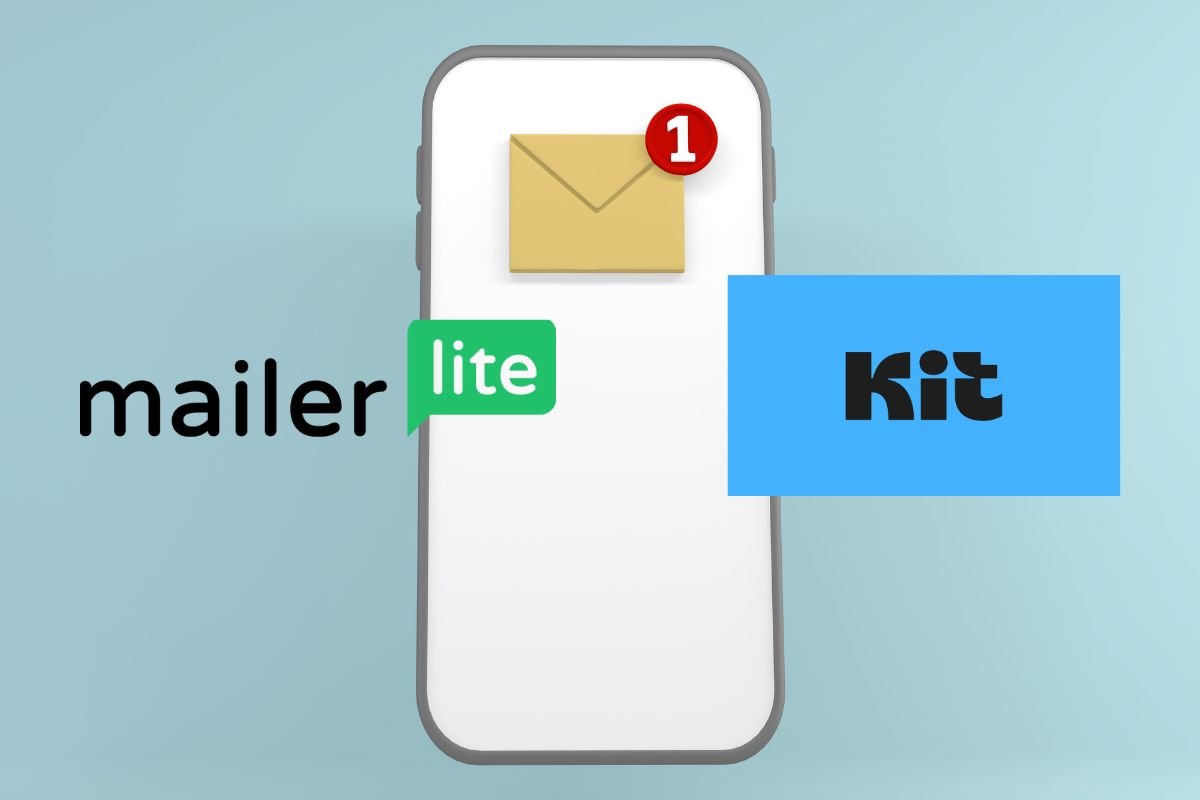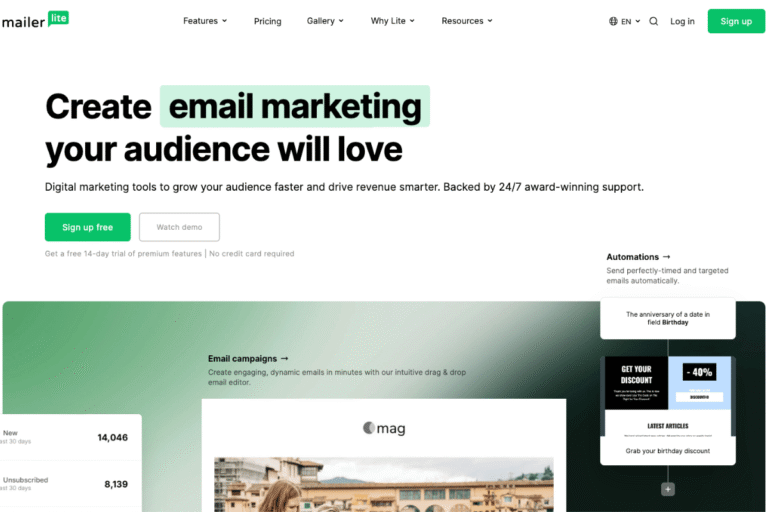
If you’re choosing between ConvertKit and MailerLite, you’re already on the right track. Both platforms punch above their weight for creators, coaches, bloggers, and lean teams. The trick is matching the tool to your growth plan: simple newsletters and landing pages today, scalable automations and sales tomorrow. In this comparison, you’ll get clear pricing snapshots, feature-by-feature breakdowns, real use cases, and step-by-step tips so you can start quickly, and avoid costly switching later.
Short version: MailerLite is the budget-friendly all-rounder with solid design tools and good automations. ConvertKit is built for creators who plan to sell, segment, and personalize at scale. Let’s dig in.
Bottom Line Up Front
Choose ConvertKit If
- You’re a creator selling digital products, memberships, or paid newsletters and you want native checkouts (no extra cart needed).
- You rely on tags and advanced segmentation to tailor content, upsells, and launches.
- You want visual automations that grow with you: multi-branch logic, events, and behavior-based targeting.
- You prioritize deliverability and simple, text-first email that looks like a real note from you.
- You’re fine paying a bit more for creator-focused features and monetization.
Real-world fit: Course creators, authors with launches, coaches running evergreen funnels, newsletter operators with paid tiers.
Choose MailerLite If
- You’re cost-conscious and want the best value at small-to-mid list sizes.
- You want attractive templates, drag-and-drop design flexibility, and lots of landing page options.
- Your automations are straightforward (welcome series, lead magnet delivery, simple nurture journeys).
- You need a friendly UI for clients or team members and easy A/B testing of designs.
Real-world fit: Agencies managing multiple client lists, local businesses, ecommerce side projects, bloggers who want a polished brand feel without complexity.
What Both Platforms Do Well
- Clean, modern interfaces with fast setup and solid onboarding.
- Good deliverability when you authenticate your domain (SPF/DKIM, optional DMARC).
- Visual automation builders, decent segmentation, and reliable broadcast/newsletter sending.
- Pop-ups, forms, and landing pages without needing a separate page builder.
- Integrations with major tools, plus Zapier/Make for long-tail connections.
If you plan to monetize with minimal tech overhead, ConvertKit edges ahead. If you want maximum design control and value per dollar, MailerLite’s tough to beat.
Pro tip: If you’re on the fence, spin up a weekend test. Build the same signup flow and welcome series in both, send a small campaign, then compare build time, reporting clarity, and engagement. You’ll know within 48 hours which one “clicks.”
Try ConvertKit →
Try MailerLite →
Pricing And Plans
Pricing changes, promos, and currencies can shift totals, always check the live pages before you buy. Here’s how costs typically compare for common list sizes and needs.
Free And Entry Tiers Compared
- ConvertKit Free: Geared toward creators testing the waters. Typically supports up to 1,000 subscribers with unlimited landing pages/forms and broadcasts. Advanced automations and some features (like advanced reporting) require a paid plan. Monetization (ConvertKit Commerce) is available with transaction fees.
- MailerLite Free: Usually up to 1,000 subscribers with a monthly email send cap and MailerLite branding on some assets. Fewer templates/automations than paid tiers, but enough to run a basic list.
Who wins free? MailerLite for design flexibility: ConvertKit if you want quick monetization tests via built-in checkout.
Feature Breakdowns By Plan
- ConvertKit Paid (Creator / Creator Pro): Unlocks advanced automations, premium support, newsletter referral features, more reporting, and better deliverability controls. Commerce remains a standout (sell products/subscriptions without extra tools).
- MailerLite Paid (Growing Business / Advanced): Removes branding, increases monthly send limits, adds advanced automations, dynamic content, AI writing/design helpers, promotion tools, and priority support on higher tiers.
Real Cost At Common List Sizes
These are ballpark monthly figures to help you budget: exact prices vary with billing cycles and add-ons, so verify live pricing.
- 1,000 contacts: MailerLite typically ~$10–$15: ConvertKit often ~$15–$29 depending on tier.
- 5,000 contacts: MailerLite typically ~$30–$45: ConvertKit often ~$66–$99.
- 10,000 contacts: MailerLite typically ~$50–$90: ConvertKit often ~$100–$140.
Value take: If your list is design-heavy newsletters with light automation, MailerLite is the value leader. If you’ll run segmentation-heavy launches, paid subscriptions, and evergreen funnels, ConvertKit’s higher price can return more revenue per subscriber.
Action tip: Estimate your 12-month subscriber growth, then model costs for the end-of-year list size, not just today’s. Switching platforms mid-launch is never fun.
Try ConvertKit →
Try MailerLite →
Email Builder, Forms, And Landing Pages
Editors, Templates, And Design Control
- ConvertKit: Emphasizes clean, minimal, text-forward emails that look personal. The editor is intentionally simple: you can still add images, buttons, and content blocks. Templates are tasteful but limited, on purpose, to protect deliverability and that “handwritten note” vibe.
- MailerLite: Drag-and-drop builder with robust blocks (carousels, countdowns, product boxes), a larger template gallery, and granular design control. If you want a brand-magazine style newsletter, you’ll get there faster in MailerLite.
Pros/Cons Snapshot
- ConvertKit pros: Simplicity, fast to ship, fewer rendering issues, high readability. Cons: Limited flashy layouts.
- MailerLite pros: Beautiful templates, flexible layouts, easier brand consistency. Cons: Over-design can hurt deliverability if you go heavy on images.
Forms, Pop-Ups, And Landing Page Options
- Both: Embedded forms, pop-ups (timed, exit-intent), and dedicated landing pages. Built-in templates make it quick to spin up a lead magnet opt-in or waitlist page.
- ConvertKit: Landing pages are creator-centric, ebook, webinar, course launch. Form targeting and incentive emails are straightforward.
- MailerLite: More visual control for pop-ups, sticky bars, and multi-step forms. If you care about fine-tuning mobile behavior and animations, it’s excellent.
Quick Start (5-minute setup)
- Create a form (choose a template).
- Connect to a list/segment (MailerLite) or tag (ConvertKit).
- Turn on the double opt-in confirmation email.
- Embed on your site or publish a hosted landing page.
- Attach a welcome automation to deliver the lead magnet.
Personalization, Dynamic Content, And Accessibility
- ConvertKit: Strong conditional content using tags and custom fields. Example: “If has_tag(customer) show upsell: else show discount.” Great for speaking differently to buyers vs prospects.
- MailerLite: Dynamic blocks and content visibility rules by segment, time, or field values. Helpful for multilingual newsletters or geo-specific promos.
- Accessibility: Both offer alt text, semantic structure, and dark-mode-friendly templates. Keep contrast high, avoid image-only emails, and use clear button labels.
Takeaway: If your brand leans visual, MailerLite feels like home. If your emails are story-driven with tight personalization logic, ConvertKit shines.
Automation, Segmentation, And Personalization
Workflow Builders: Triggers, Filters, And Actions
- ConvertKit: Visual automations with events (e.g., tag added, purchase made), conditions, and actions across multiple paths. It’s easy to build evergreen funnels, launches, webinar sequences, and post-purchase nurtures.
- MailerLite: Visual automations for common flows, welcome series, date-based sequences, behavior triggers like link click or form signup. It handles most small business needs without feeling overwhelming.
Step-by-Step: Build a Lead Magnet Funnel
- Trigger: Form submitted.
- Action: Add tag (ConvertKit) or add to group/segment (MailerLite).
- Email 1: Deliver the asset immediately.
- Delay: 2–3 days.
- Email 2–4: Nurture with quick wins and a soft CTA.
- Branch: If clicked pricing link, send case study: else send value email.
- Exit: Add to newsletter segment and exclude from promo for 7 days.
Tagging, Groups, And Advanced Segmentation
- ConvertKit: Tagging is the backbone. You can layer tags (interests, lifecycle stage, products owned) and use custom fields to drive granular targeting. Powerful for cohort-based promos.
- MailerLite: Uses segments and groups. You can create rules based on activity, fields, location, or ecommerce data (via integrations). It’s intuitive for teams moving from Mailchimp.
Advanced ideas:
- Interest-based tagging from link clicks in a “choose-your-path” email.
- Activity buckets (engaged, at-risk, cold) with automatic pruning rules.
- Launch warmups that exclude recent purchasers and VIPs.
Behavioral Targeting And Conditional Content
- ConvertKit: Conditional blocks make it trivial to show different offers in the same email based on tags or purchases. Great for layered promotions without duplicating campaigns.
- MailerLite: Dynamic blocks by segment or field values work well for localization, product categories, or loyalty tiers.
If precise targeting and creator commerce are central, ConvertKit’s logic feels more native. For most day-to-day automations, MailerLite is plenty, and kinder to beginners.
Ecommerce And Creator Monetization
Selling Digital Products, Subscriptions, And Checkouts
- ConvertKit: Built-in Commerce lets you sell digital downloads, courses, coaching, and paid newsletters without a separate cart. You get hosted product pages, checkouts, and subscriber-only content, perfect for a lean stack.
- MailerLite: No native cart, but strong integrations with Stripe, Shopify, WooCommerce, ThriveCart, Lemon Squeezy, and more. If you already have a storefront, MailerLite plugs in nicely.
Use Cases
- Paid newsletter beta: ConvertKit can spin this up in a morning, product, checkout, tag buyers, trigger welcome sequence.
- Ecommerce list growth: MailerLite + Shopify to sync customers, send abandoned cart emails, and segment by purchase behavior.
Payments, Taxes/VAT, And Currencies
- ConvertKit: Processes payments for digital products using Stripe under the hood. Offers basics for taxes/VAT collection and receipts: country availability and currency support depend on Stripe coverage.
- MailerLite: Tax/currency handling offloaded to your ecommerce/payment stack. If you need advanced VAT/GST logic, pair with a specialized checkout (e.g., Paddle, Lemon Squeezy) and sync buyers back to MailerLite.
Coupons, Upsells, And Transaction Fees
- ConvertKit: Simple coupons/discounts and straightforward product setup. There are transaction fees on sales via Commerce (check current rate), which you’ll weigh against not paying for a separate cart.
- MailerLite: Coupons/upsells managed by your store/checkout app, not MailerLite itself. More flexibility if you’re already using a robust ecommerce platform.
Bottom line: If you don’t want to wrangle a cart, ConvertKit is turnkey. If you already run a store and want a great newsletter + automations combo, MailerLite integrates cleanly.
Deliverability And Compliance
Sender Authentication: SPF, DKIM, And DMARC
Both platforms guide you through adding SPF/DKIM records and optionally DMARC to your domain. This is essential for Gmail/Yahoo compliance updates and inbox placement. Plan for 10–20 minutes with your DNS host.
List Hygiene, Consent, And Spam Prevention
- Double opt-in or at least confirmation on high-risk forms (giveaways) to keep bounces/complaints down.
- Regularly prune cold subscribers or run a re-engagement campaign before removing them.
- Avoid image-only emails, misleading subject lines, and link shorteners.
Both tools include unsubscribe management, preference centers, and basic compliance tools for GDPR/CCPA. ConvertKit’s text-first approach naturally avoids many spam triggers: MailerLite offers spam-check and testing features to help you balance design and deliverability.
Infrastructure, Inbox Placement, And Reliability
- Both: Solid IP reputation, shared infrastructure with good sender scoring when you follow best practices. Uptime is consistently strong.
- Tips: Warm up new domains, keep consistent sending cadence, and authenticate your sending domain before the first campaign. Your behavior matters more than the platform logo on the server.
Integrations, API, And Migration
Native Integrations And Connectors (Zapier/Make)
- ConvertKit: Deep connections with creator tools (Teachable, Gumroad, Kajabi, ThriveCart), checkout sync, webinar platforms, and calendar/booking apps. Zapier/Make unlock everything else.
- MailerLite: Broad marketing stack coverage, Shopify, WooCommerce, WordPress, Elementor, Typeform, Calendly, Facebook Ads, and more. Agencies like the workspace/client features.
CMS, Website Builders, And Ecommerce Platforms
- WordPress: Both have official plugins and block widgets for easy embedding.
- Shopify/Woo: MailerLite is particularly friendly for storefronts with product blocks and ecommerce automations: ConvertKit integrates too but focuses more on creator-product flows than SKU catalogs.
- Webflow, Squarespace, Carrd: Both offer copy-paste embeds and hosted pages if you don’t want to mess with DNS.
Import Tools, List Migration, And Recreating Automations
Migration checklist (1–2 hours for small lists):
- Export subscribers with tags/segments and custom fields from your current tool.
- Clean the file (remove hard bounces/complaints).
- Import into ConvertKit/MailerLite with matching fields.
- Recreate key automations: welcome series, lead magnet delivery, evergreen funnel, cart/checkout triggers.
- Rebuild forms/landing pages: update embeds on your site.
- Authenticate your sending domain: send a warm-up campaign.
Both platforms offer importers and step-by-step docs. If you’re moving complex branching logic, ConvertKit’s visual automation builder usually recreates 1:1. MailerLite handles the common flows elegantly: for niche triggers, lean on Zapier/Make.
Try ConvertKit →
Try MailerLite →
Ease Of Use, Reporting, And Support
Onboarding And Daily Workflow Experience
- ConvertKit: Minimalist UI. You’ll move quickly between subscribers, broadcasts, sequences, and automations. It “gets out of your way,” especially if you write text-first emails.
- MailerLite: Polished, visually guided. The email builder is delightful, and managing multiple forms/landing pages feels organized.
Day-in-the-life
- Write newsletter → segment → schedule → skim pre-send checks → ship. Both do this well: MailerLite’s pre-send design preview is a bit richer, ConvertKit’s segmentation and exclusion logic is a touch faster.
Analytics, A/B Testing, And ROI Tracking
- ConvertKit: Clear per-broadcast metrics, link heatmaps, subscriber activity timelines, and tagging-based cohort views. Commerce sales are tracked natively when you sell via ConvertKit.
- MailerLite: Strong campaign analytics, device/client breakdowns, click maps, and subject line A/B testing. Ecommerce revenue attribution available via integrations.
Recommendation: Set up UTM parameters on links in both tools. Pair with Google Analytics or your analytics stack to validate attribution beyond open rates (which are now less reliable due to privacy protections).
Help Channels, Community, And Learning Resources
- ConvertKit: Knowledge base, email/chat support, webinars, and an active creator community. Excellent educational content for creators.
- MailerLite: Documentation, support, video tutorials, and responsive chat on paid plans. Agency-friendly help for client setups.
Both are well-supported. If you value community and creator education, ConvertKit has an edge. If you want how-to videos for building pretty pages fast, MailerLite’s tutorials are plentiful.
Conclusion
If your plan is to grow an audience and monetize with as little tech overhead as possible, ConvertKit is the safer long-term bet. Its tagging, conditional content, and native Commerce let you ship launches, paid newsletters, and evergreen funnels without stitching five tools together.
If you want a budget-friendly platform with beautiful templates and solid automations, MailerLite is a joy to use, especially if you already sell via Shopify, Woo, or a separate checkout.
A smart path is to test both this week:
- Rebuild your core flow (form → welcome → nurture) in each.
- Send one newsletter and one automated sequence.
- Compare build time, engagement, and how confident you feel reading the reports.
Then choose and commit. The best tool is the one you’ll use consistently.
When you’re ready:
- Try ConvertKit →
- Try MailerLite →
Use those links to support this site (at no extra cost). Whichever you pick, set up domain authentication, a simple welcome series, and your first lead magnet today. Momentum beats perfect every time.
ConvertKit vs MailerLite: Frequently Asked Questions
What’s the main difference in ConvertKit vs MailerLite for creators?
MailerLite is the budget-friendly all-rounder with polished templates and flexible landing pages. ConvertKit focuses on creators who sell, segment, and personalize at scale, with native checkouts and powerful tagging/conditional content. Choose MailerLite for design value; choose ConvertKit if monetization and precise targeting drive your strategy.
How do ConvertKit vs MailerLite prices compare at common list sizes?
At roughly 1,000 contacts, MailerLite often runs ~$10–$15 and ConvertKit ~$15–$29. Around 5,000 contacts, MailerLite ~$30–$45 vs ConvertKit ~$66–$99. At 10,000, MailerLite ~$50–$90 vs ConvertKit ~$100–$140. Always confirm live pricing, promos, and billing cycles before you decide.
Which platform handles automations and personalization better?
Both have visual builders. ConvertKit excels at advanced logic—events, tags, and granular conditional content—ideal for launches, evergreen funnels, and buyer-specific messaging. MailerLite covers most small business needs with clear workflows, dynamic blocks, and segment rules—great for straightforward welcomes, nurtures, and design-driven newsletters.
How should I test ConvertKit vs MailerLite before choosing?
Run a weekend trial in both. Rebuild the same flow (form → welcome → nurture), send a small campaign, then compare build speed, segmentation ease, reporting clarity, and engagement. You’ll quickly see which UI and workflow “click” for you—and avoid an expensive mid‑launch switch later.
When should I switch from MailerLite to ConvertKit as my list grows?
Consider switching when you outgrow simple automations and need revenue-focused features: granular tagging, behavior-based branches, subscriber-specific offers, and native paid newsletters/checkouts. If your launches, upsells, or memberships feel constrained by design-first tooling, ConvertKit’s creator commerce and targeting often justify the higher cost.
Can I use both tools during migration without hurting deliverability?
Yes—briefly. Authenticate your sending domain in the new tool, warm up by sending to engaged segments first, and avoid blasting from both platforms simultaneously. Keep one source of truth for subscribers, disable duplicate automations, add UTMs for tracking, and wrap the overlap within 2–3 weeks.


